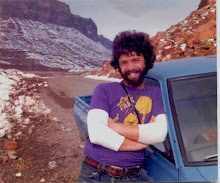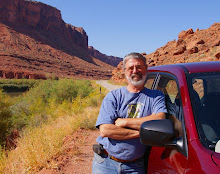
March 19 - I bid an early morning farewell to the Econo Lodge and eagerly left Mojave behind, driving north on Highway 14 toward Ridgecrest. This is not the consummate desert drive, by any means but a long, barren stretch of roadway flanked by the Tehachapi Mountains to the west and miles of creosote flatlands to the east. At the nearly deserted crossroads of Olancha, one turns east on highway 190 which follows the south shore of Owens Dry Lake. This is a lake that used to be a vital waterway before being diverted in the early part of the 20th century to support the burgeoning city of Los Angeles. Now it is just a dusty white sheet across the landscape.
As with Zion National Park, this week marked the 43rd anniversary of my first visit to Death Valley which was part of a geology field class out of Foothill College in the spring of 1967. My first ever glimpse of southwestern deserts and the beginning of a lifelong love affair. For some people, Death Valley may be the hardest of all American deserts to love. It is certainly the harshest and most intimidating. That includes the narrow, winding route from the west which climbs over the Argus Range, drops steeply into the Panamint Valley, climbs again over the Panamint Range, then drops even more steeply into Death Valley itself. The temperature at 5,000’ Towne Pass was 53 degrees. By the time I reached Stovepipe Wells, near sea level, it was a warm 75 degrees. Just before I reached Furnace Creek, a lone coyote loped across the road in front of me. It was almost as if he was the official greeter.
The one thing I had not anticipated was just how many other people might have the same idea as I did about getting away to some hot desert country. The campgrounds in the Valley were all pretty crowded, and Furnace Creek was alive with activity. By the time I got to Texas Spring, there were only about six pathetic sites left. So I took the least pathetic of the lot, a 200’ square foot chunk of gravel across from the campground host, the restroom, and a telephone booth. It was a real comedown from my bucolic space at the Carrizo Plain, but I vowed to make the best of it. After all, it was now nearly 85 degrees and I was wearing shorts and a t-shirt for the first time in months.
I spent the remainder of the afternoon driving south to Badwater which was bad for lighting and bad for solitude at the moment. Lots of folks scrambling around on the salt flats. Artists Drive was busy as well, and the trail head parking at Golden Canyon was nearly full. So I repaired to Furnace Creek for a few supplies, then returned to my campsite where I found shade in the shadow of the Subaru and started reading Raymond Chandler’s The Big Sleep. I figured I would pass the time until dusk when I could drive back out to Stovepipe Wells and catch the optimum light on the sand dunes.
 It is a nearly 30 mile drive back to Stovepipe Wells from Texas Spring but I timed my arrival pretty well as the shadows were lengthening on the dunes. I avoided the official parking lot where tourists were climbing like ants all over the sand and marring the dune patterns. Instead I went down the road a bit farther, parked on a shoulder, and walked in from a less utilized location. I spent the next forty minutes or so wandering through the mounds and hummocks of sand, photographing ripples, mud cracks, and shadowed slopes. I was not disappointed.
It is a nearly 30 mile drive back to Stovepipe Wells from Texas Spring but I timed my arrival pretty well as the shadows were lengthening on the dunes. I avoided the official parking lot where tourists were climbing like ants all over the sand and marring the dune patterns. Instead I went down the road a bit farther, parked on a shoulder, and walked in from a less utilized location. I spent the next forty minutes or so wandering through the mounds and hummocks of sand, photographing ripples, mud cracks, and shadowed slopes. I was not disappointed.By the fading light of dusk, I headed back to my campsite, mesmerized by the multicolored landscape. I vowed to get up early the next morning and beat the crowds to some of my favorite spots.




Very Interesting, What suspense, can't wait till the next installment.
ReplyDeleteAs I read about Death Valley, I can't help but think about the line, "Americans are loving their National Parks to death." I am so glad that Greg can still see the beauty through the crowds and share that observation with us.
ReplyDelete